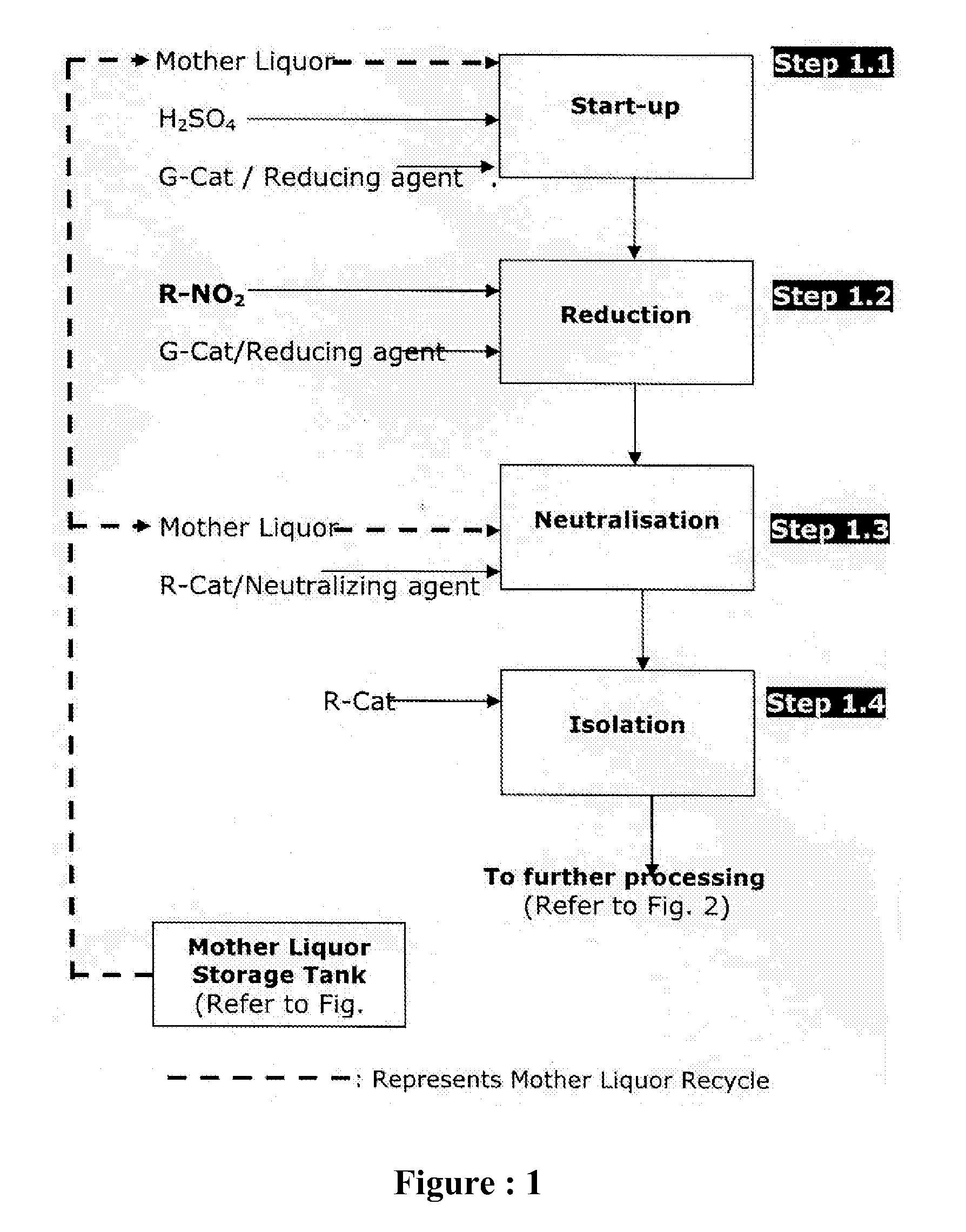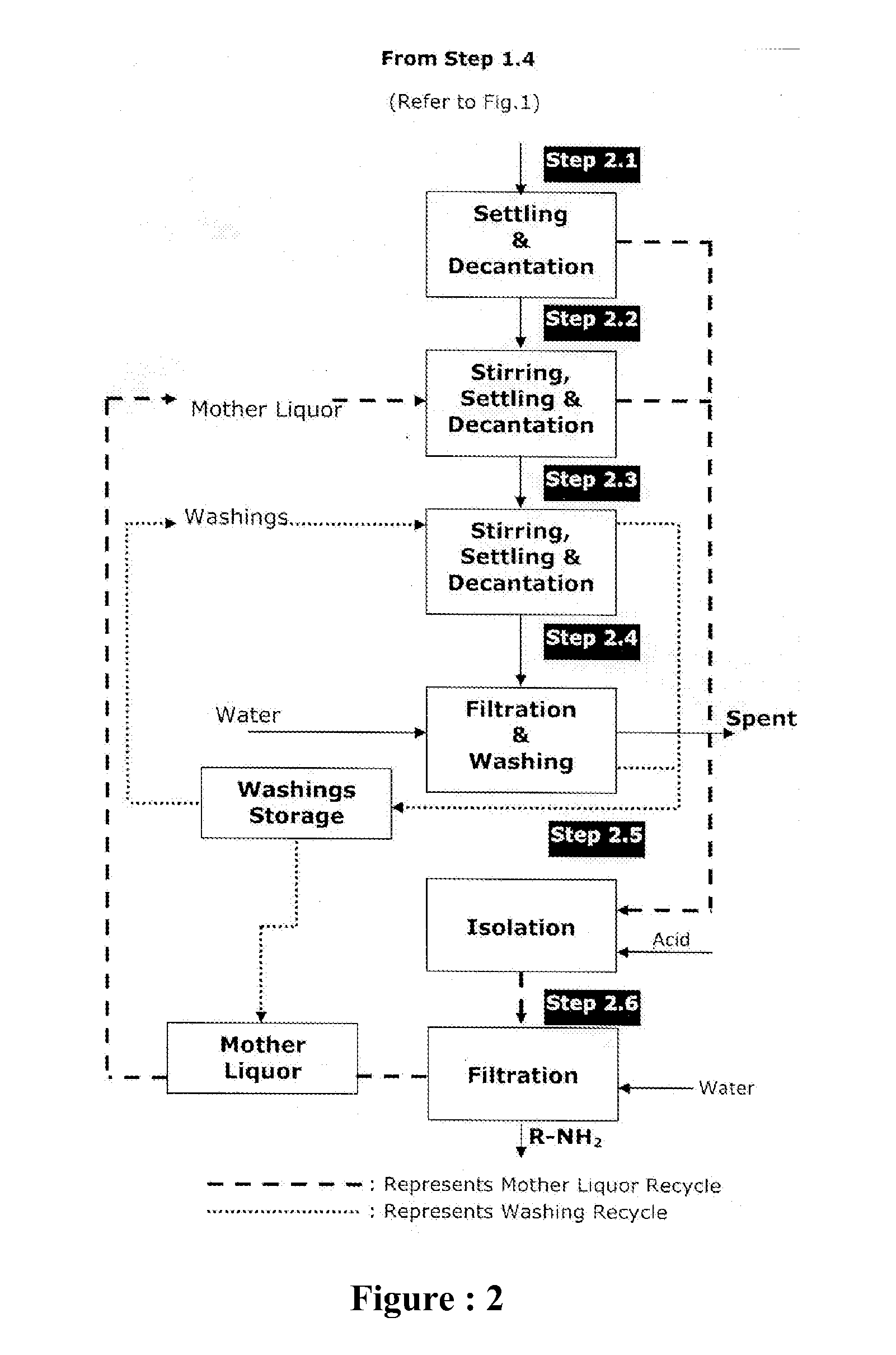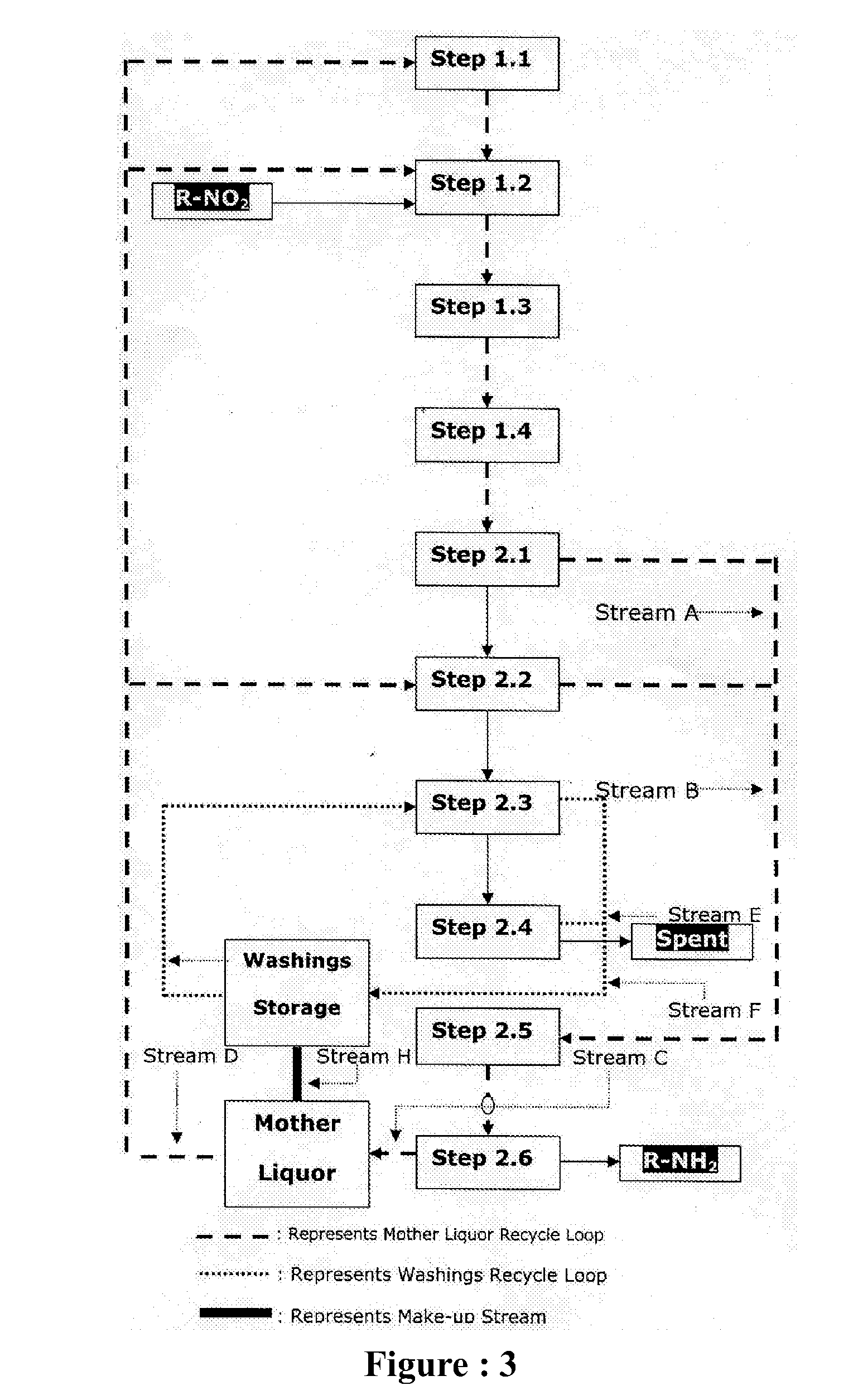Sustainable chemical process for reduction of nitro compounds (R-NO2) or nitroso compounds (R-NO) containing sulphonic or carboxylic group into corresponding amino compounds (R-NH2) with inherent recycle of all acidic streams generated in synthesis
a chemical process and synthesis technology, applied in the direction of amino group formation/introduction, amino compound preparation, hyroxy compound preparation, etc., can solve the problems of difficult recycling of large quantities of liquid waste, and the handling of pyrophoric and/or explosive materials, etc., to achieve the effect of reducing the number and quantity of organic and inorganic impurities, reducing the possibility of side products in acidic mother liquor during recycl
- Summary
- Abstract
- Description
- Claims
- Application Information
AI Technical Summary
Benefits of technology
Problems solved by technology
Method used
Image
Examples
example 1
4 Nitro 4-amine diphenyl amine 2 sulphonic acid to 4,4 diamine diphenylamine 2 sulphonic acid
[0142]Fresh cycle: In a round bottom flask equipped with stirrer, condenser, thermometer, addition port arranged in suitable heating / cooling system was charged 400 ml water, heated to 98° C. Charged 2 ml 98% H2SO4 to get pH 2.0 and 9.5 g G-CAT start up with continuous stirring at 98° C. First lot of 5.60 g G-CAT and first lot of 14.2 g Nitro was charged to the reaction mass in 10 min. The reaction mass was maintained for 5-10 min at 98° C. Remaining G-CAT & Nitro was charged in four equal lots in similar manner as followed for first lot. Reaction mass was maintained at 98° C. for 30 min. 17.0 g Na2CO3 was charged during 60 min to adjust pH of reaction mass to 10.5 and maintain for 15-20 minutes. Then it is decanted and collected in separate flask for further processing. Charged 300 ml water was charged for extraction, maintained temperature 98° C. and stirring was stopped and upper liquid la...
example 2
Meta dinitro sulphonic acid to m-phenylenediamine 4-sulphonic acid
[0149]Fresh cycle: In a round bottom flask equipped with stirrer, condenser, thermometer, addition port arranged in suitable heating / cooling system was charged 175 ml water, heated to 80° C. Charged 10 ml (30%) HCl to get pH 2.0 and 25.0 g G-CAT start up with continuous stirring at 95-100° C. First lot of 9.0 g G-CAT and first lot of 12.8 g Nitro was charged to the reaction mass in 10 min. The reaction mass was maintained for 5-10 min at 95-100° C. Remaining G-CAT & Nitro was charged in four equal lots in similar manner as followed for first lot. Reaction mass was maintained at 95-100° C. for 30 min. Then charged 4.0 g R-Cat was charged during 30 min to adjust pH of reaction mass to 7.0 and maintain for 15-20 minutes. Then it is filtered and spent catalyst is again washed 100 ml hot water to get 129 g wet inorganic by-product with moisture 23% and amine content 0.70%. The combined mass of product & wash filtrate is th...
example 3
4-4 Di Nitro Stilbene-2-2 Disulphonic Acid (DNSDA) to 4-4 Di Amino Stilbene 2, 2 Di Sulphonic Acid (DASDA)
[0155]Fresh cycle: In a 1-Liter-4-neck round bottom flask equipped with stirrer, condenser, thermometer, addition port arranged in suitable heating / cooling system was charged 300 ml water, heated to 80° C. Charged 6 ml 30% H2SO4 to get pH 2.0 and immediately charged 40 g G-CAT start up with continuous stirring at 80° C. First lot of 15.2 g 4-4 Di Nitro Stilbene-2-2 Disulphonic Acid (DNSDA) was charged to the reaction mass in 10 min. The reaction mass was maintained for 5-10 min at 98-100° C. Remaining lots of 4-4 Di Nitro Stilbene-2-2 Disulphonic Acid (DNSDA) was charged in four equal lots in similar manner as followed for first lot. Reaction mass was maintained at 98-100° C. for 30 min. Then 5.0 g R-Cat was charged to adjust pH 8.5. Then it is filtered & collected in separate flask for further processing. 200 ml hot water wash given to solid inorganic by-product, remaining in t...
PUM
| Property | Measurement | Unit |
|---|---|---|
| temperature | aaaaa | aaaaa |
| temperature | aaaaa | aaaaa |
| Weight Ratio | aaaaa | aaaaa |
Abstract
Description
Claims
Application Information
 Login to View More
Login to View More - R&D
- Intellectual Property
- Life Sciences
- Materials
- Tech Scout
- Unparalleled Data Quality
- Higher Quality Content
- 60% Fewer Hallucinations
Browse by: Latest US Patents, China's latest patents, Technical Efficacy Thesaurus, Application Domain, Technology Topic, Popular Technical Reports.
© 2025 PatSnap. All rights reserved.Legal|Privacy policy|Modern Slavery Act Transparency Statement|Sitemap|About US| Contact US: help@patsnap.com



